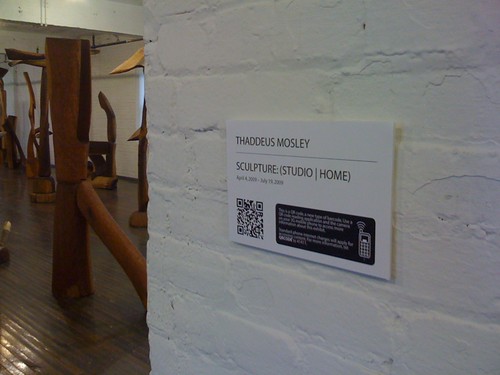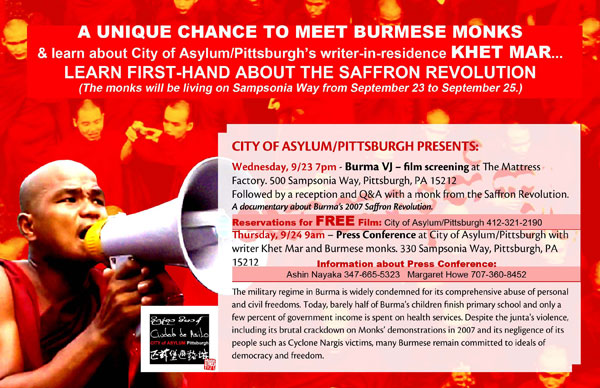Approximately one year ago, the Mattress Factory
began experimenting with QR (or Quick Response) codes and this past April the museum became the first in the United States to utilize the technology on-site as a visitor engagement tool. More on that
HERE. Our use of QR Codes in the galleries has been getting some attention (
1,
2), and I've fielded numerous inquiries from artists and arts organizations wishing to utilize this technology in their practice or operations.
One can only presume that, as 2D barcode technology continues to evolve and becomes more accessible to more people, more artists and arts orgs will want to utilize it. And on the heels of that interest comes people and companies that will attempt to capitalize from providing clients with an essentially open (read: FREE) technology. So, in an attempt to save our fellow artists a boat-load of money, we decided to publish a step-by-step guide for those who wish to experiment with QR code technology.
No consulting firm needed. Please keep in mind that this is only how we here at the MF implemented the codes. If you think there are better ways, or workarounds, please share in the comments to the post.
STEP 1: Upload Killer Content (IMPORTANT!!)Give people or visitors a reason to open the codes. The codes we place throughout the galleries
contain link to mobile browser optimized (JI - 9/15/09) rich multi-media content that provides context or backstory to the artworks we exhibit. We upload
video files to YouTube,
behind-the-scenes still images to Flickr, and informative
text-based PDF files, all of which are
supported by QR code technology accessible via most mobile platforms (JI - 9/15/09). Universal codes that access a stagnant website may prove to be less interesting to your audience.
STEP 2: Generate the CodesOnce you have developed the content you wish to share with your audience, it's time to make the codes. We use a
very simple web generator provided by Kaywa. This generator is nice because it provides output & resolution options. If you're creating a print piece, you can select the extra large file output which optimizes quite nicely for signage.
Because the density of information contained within a code can effect its readability, we shorten all URLs with
http://bit.ly. This may seem like a frivolous extra step, but it greatly impacts the ease with which our codes are read. Below are two codes that open the same URL. The URL embedded in the less dense code on the right has been shortened making this code easier and more consistently read.
 STEP 3: Place or Hang Codes In Desired Locations
STEP 3: Place or Hang Codes In Desired LocationsOnce we generate our codes, we design the signage and collateral materials that will hold them. Codes can be displayed and read in hardcopy or electronic (screen) format. The only obstacle we've experienced has been customizing the size of the codes. Ideally, we'd like the codes to be smaller (i.e. 3/4" x 3/4"), but the smallest we've been able to go with consistent readability has been 1.5" x 1.5". As QR technology and hardware progresses, I anticipate the ability to reduce code sizes will emerge in the near future.
 Mattress Factory gallery card containing a QR code.STEP 4: Introduce the QR Codes to Users in a Non-Intimidating Way
Mattress Factory gallery card containing a QR code.STEP 4: Introduce the QR Codes to Users in a Non-Intimidating WayLet's face it. The unknown scares people. And new technology has a way of intimidating potential users. We knew going into this that it was imperative to present the codes to visitors through technology they were already familiar with. We started by hanging several
"This is a QR Code" signs in the museum lobby and elevator. These signs contain a short description about what the codes are.

We knew visitors would have more questions about the codes that would be impossible to answer through signage, so we created a simple text message (SMS) info relay. Through
TextMarks, an inexpensive and easy SMS shortcode provider, visitors who send the keyword QRCODE to TextMarks' shortcode receive an immediate reply containing two links. The first link directs the user's mobile phone browser to a site that detects what type of phone they're using, provides more information, and a FREE download of the appropriate code reading application.
The 2nd link directs iPhone users to App Store, where they can download the most current FREE version of the BeeTagg Multicode Reader. There are numerous barcode reading applications available on most mobile platforms, but we recommend
BeeTagg because of it's universality across the spectrum. In fact, factory-installed readers are now common on many phones including Nokia devices and the G1 Android. This SMS information relay has proved to be a vital piece to our QR code puzzle and has served those visitors curious about the technology greatly.
QR CODE WRAP-UPSo this is what worked for us. I'm interested to hear if other organizations find this information useful and beneficial. For further reading about QR codes in a museum setting, check out
how the Powerhouse Museum in Australia has been using them. If you have further questions or a tip that might help others to implement innovative use of QR codes, feel free to leave a comment. If you'd like to hit me up off-line,
shoot over an email or
track me down on Twitter.
 One of the most unfortunate occurances for me last year was being out of town during PodCamp Pittsburgh 3, which took place in October of 2008. Well, lucky for me (and hopefully you!) PodCamp Pittsburgh 4 is coming up in a just few short weeks (October 10 + 11). For those of you thinking, "Pod-what?," PodCamp is a FREE community UnConference, run by and for people who create, enjoy, or are interested in learning more about social media.
One of the most unfortunate occurances for me last year was being out of town during PodCamp Pittsburgh 3, which took place in October of 2008. Well, lucky for me (and hopefully you!) PodCamp Pittsburgh 4 is coming up in a just few short weeks (October 10 + 11). For those of you thinking, "Pod-what?," PodCamp is a FREE community UnConference, run by and for people who create, enjoy, or are interested in learning more about social media.



 We knew visitors would have more questions about the codes that would be impossible to answer through signage, so we created a simple text message (SMS) info relay. Through
We knew visitors would have more questions about the codes that would be impossible to answer through signage, so we created a simple text message (SMS) info relay. Through